Authored by Moera Gutu Jiru*,
Abstract
Majority of the conventional materials have been replaced by Natural fiber composites due to their high strength to weight ratio, biodegradable, eco-friendly environment. Based on various literature surveys, natural fibers are a very good alternative for the Engineering and Manufacturing industries. The main goal of this work is to investigate the effect of fiber orientation and wt.% composition on mechanical properties. Fabrication of the composite was made from a hybrid polymer matrix reinforced with nettle fiber (NF), sisal fiber (SF), and glass fiber (GF). Different compositions wt.% of nettle and sisal fiber were used with 0°/90° and 45° orientations. A 5% NaOH was used for both fibers to remove further lignin, hemicellulose, and other fiber remnants. The total volume fraction of the fiber was 40 wt.%. From this wt.% of nettle and sisal fibers were hybridized as 20NF:10SF, 15NF:15SF, and 10NF:20SF through 0°/90° orientation by keeping wt.% glass constant. The mechanical property results for those samples were very good. In this case, the tensile load and impact force was applied in the direction of both fibers sample S5 and S5’. In the case of S5, the load was applied longitudinally to SF. Whereas in S5’ the load was applied longitudinally to NF. Tensile and impact strength of S5 and S5’ were 97MPa, 8.4J, and 91MPa, 6.9 J respectively. Therefore, it is possible to say that hybrid composite which shows good mechanical property can be manufactured from locally available nettle fiber which is not well known in composite and sisal plant fiber.
Keywords: Hybrid composites; Nettle fiber (NF); Sisal fiber (SF); Glass fiber (GF); Hand lay-up; Polyester
Introduction
Composite materials are heterogeneous mixtures of two or more homogeneous phases, which have been bonded together. Composite materials are used in different application areas like transportation in automobile and railway coach interior. They can also be used for storage devices, furniture, everyday applications for building components [1,2]. Researchers have begun to focus attention on natural fiber composites like coir, jute, sisal, banana, hemp, and bagasse fibers which are composed of natural or synthetic resins, reinforced with natural fibers. Natural fibers show many advantageous properties due to low density which gives lightweight for the composites and hence composites are cost-effective [3]. In the 1970s and 1980s, new types of composites have been developed to meet the strict requirements of aircraft and space industries [4].
The main disadvantages of natural fibers and matrix are relative to high moisture absorption. Therefore, chemical treatments with sodium hydroxide (NAOH) are considered in modifying the fiber surface properties since it removes the impurities like pectin, facts, and lignin in the fiber [5]. It also improves the bond between fiber and matrix for enhancing mechanical properties like tensile, flexural, and compression strength of the composite [6]. Ramesh et al. [7] made-up composite specimens of different weight % of alkaline treated sisal fibers and improved mechanical properties of composite by increasing fiber percentage. Dixit et al. [6] studied the result of hybridization on mechanical properties of coir where tensile and flexural properties of hybrid composites are improved as compare to nonhybrid composites. Olusegun et al. [8] evaluated the mechanical properties of ukam banana, sisal, hemp, coconut and e-glass fiber reinforced by the hand layup methods where mechanical properties of natural fiber reinforced hybrid composites were affected by amount and type of fibers. Vikas Sahu, et al. [9] investigated hybrid composites from sisal/pineapple fibers of 100/0, 70/30, 50/50, 30/70, and 0/100 weight fraction ratios. The result showed that 50/50 fibers weight fraction of sisal with pineapple fiber has an impact strength of 47.2 N⁄mm2 as compare to other constitutes of sisal with pine fibers.
Kumar et al. [10] fabricated Himalayan bast fibers, nettle fiber with bauhinia Valhi fiber-based mono/hybrid epoxy composites at varying weight percentages from 2-6 wt% and evaluated the physical property like void fraction and water absorption. The sliding wear properties of as-fabricated composites improved mechanical properties up to 34.04 MPa strength, 42.45 MPa flexural strength, and 37.01 Hv hardness. Fischer et al. [11] also investigated nettle as reinforcement for future development will be to improve the fiber-matrix interaction to increase especially the tensile strength of the composites by closing the large gap between fiber and matrix strength. Rao et al. [12] studied nettle stems that contain a bast fiber that has been traditionally used for the same purposes as linen and is produced by a similar retting process. Unlike cotton, nettles grow easily without pesticides. The fibers are coarser. In recent years, a German company has started to produce commercial nettle textiles [13].
The authors have selected the nettle fiber to explore the potential of this plant with sisal and synthetic glass fiber as reinforcement in composite material. The objective of the present study was to improve the mechanical behavior of the composite material and investigate the effect of different fiber weight percentages and orientation angles. Bidirectional woven nettle fiber, sisal fibers, and glass fibers were selected to make the hybrid composite [14,15].
Materials and Experimental Details
Materials
Local natural fiber plant nettle and sisal, and synthetic glass fiber were used as reinforcement whereas general-purpose polyester was used as matrix material. Before fabricating the expected composite materials, the composition ratio of the fibers and orientation degree of the fibers must be specified. Table 1 shows experimental parameters for the composition and wt.% of fibers.
Table 1: Orientation and wt. % composition of Nettle to sisal fibers with glass fiber.

Fabrication of the composite
Figure 2 shows the photographs of the fabrication process from natural fibers to the final composite product in the form of a plate of 5 mm thickness. Figure 3 (a) shows mold fabrication and Figure 3(b) shows fabricated samples and Figure 3(c) shows samples prepared for testing. A mold used in this work is made of stainless steel of 400 x 350 x 3mm dimensions. The fabrication of the composite material was carried out through the hand lay-up technique. The top, bottom surfaces of the mold and the walls are coated with Wax and allowed to dry. The function of the top plate is to cover, compress the fiber after the polyester resin is applied. The composite is fabricated by using the hand layup technique. But the drawback of the process is compromised. The mold was cleaned and (PVA) polyvinyl alcohol was applied on the surface of the mold and mold realizing wax was used to make the product removal easier. A gel coat was applied to the mold with the help of a brush with uniform thickness to get the better surface finish of the expected product. The general purpose resin matrix is prepared with a pre-determined composition of 1% with a catalyst which facilitates the drying process of the composite and it was stirred with simple mechanical stirring to mix properly, till the mixture became warm (exothermic reaction) (Figure 1).
First, introduce a small amount of composed resin over the gel coat of the mold and then laid E-glass fiber equivalently, then proceed to add enough amount of matrix while pushing with roller brush to spread properly and prevent the formation of a bubble. After checking that it has been poured properly the second layer (natural fiber) is laminated forms fiber sandwich composite. Clamps were tightened to expel excess matrix material from the mold cavity and also to avoid the formation of voids that could be caused by air spaces. The composites were removed from the mold and post cured in the air for another 24 hours. And then the specimen is prepared according to the ASTM standards machine specification to be tested.
Testing standards
After fabrication, the test specimens were subjected to various mechanical tests as per ASTM standards. The standards followed are ASTM D3039 for the tensile test of specimen dimension is 300 mm x 30 mm 4.5mm. The tensile test was conducted at Ethiopian Conformity Assessment Enterprise in Addis Ababa, Ethiopia. The UTM is connected with a computer display which allows us to print the test output (stress-strain curve in this case). The impact strength of the composite specimens was determined using a Charpy impact tester as per (ISO 9001:2001) Standard. The impact test was performed over the samples of length 55 mm, width 10 mm & thickness 4.5mm (Figure 3&4).
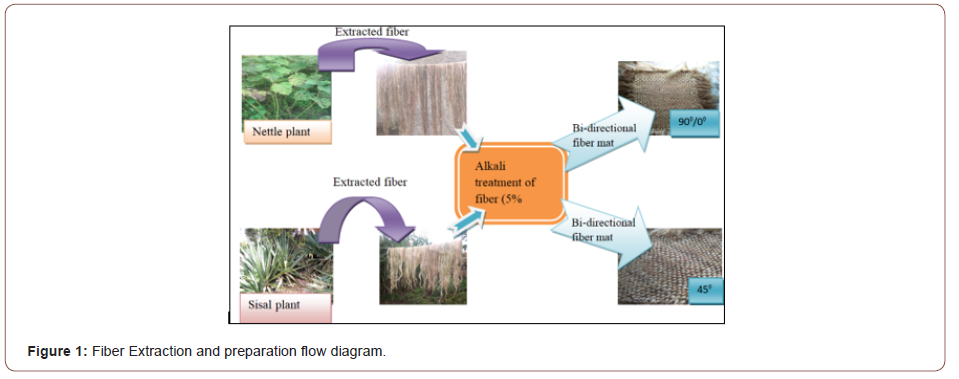

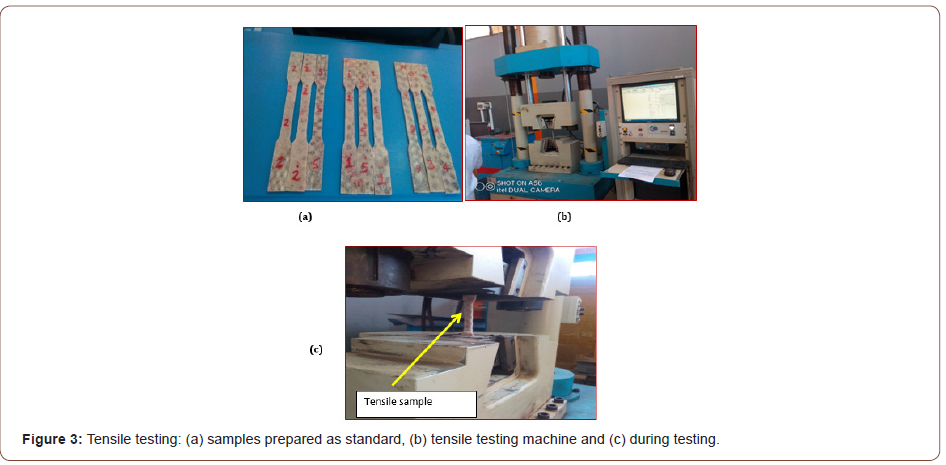
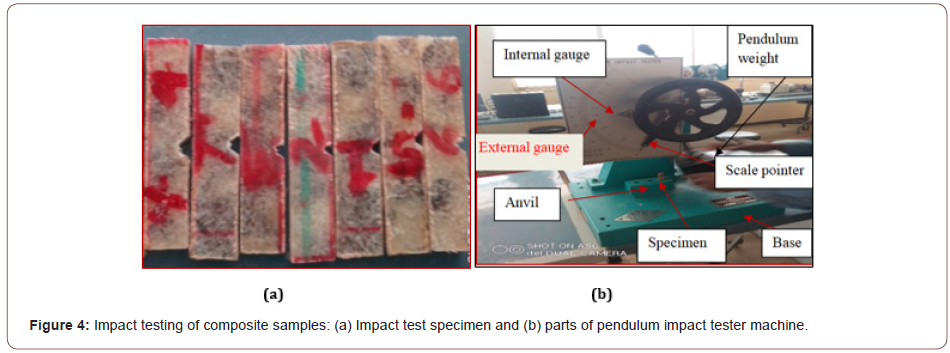
Results and Discussions
Tensile test
Nettle, sisal, and glass fiber reinforced hybrid composite was fabricated with 40% fiber volume fraction and 60% matrix volume fraction in a [0°/90° and 45°] orientation structural composite. Based on mass %w 20NF, 15NF, 10NF, and 10SF, 15SF, 20SF with 10GF were used for each preparation of the composite respectively. Nine specimens were used for this typical test. For 90°/0° fiber orientation (Sample 1, 2, and 5) two specimens were tested for each. The reason was to test through sisal and nettle fiber longitudinal direction. But for 45° fiber orientations (sample 3, 4, and 6) one specimen was tested for each because the load applied during the test can meet both fibers.
Tensile results were given for 90°/0° fiber orientation composite in Figures 5, 6, and 7 show that the fabricated composite with nettle, sisal, glass fiber, and polyester resin has a tensile strength of 99 MPa, 74 MPa, 97 MPa with a percent of elongation 21.0%, 6.2%, and 6% respectively. In Figure 5, the nettle fibers longitudinal direction arrangement is perpendicular to that of the applied force vector and the sisal fiber longitudinal direction arrangement is parallel to that of the applied force vector. The matrix, force transmitting component from one fiber layer to another is expected to fail early due to layer separation. The arrangement of the fibers for Figures 6 and 7 (samples 2 and 5) was the same as the arrangement of sample 1.
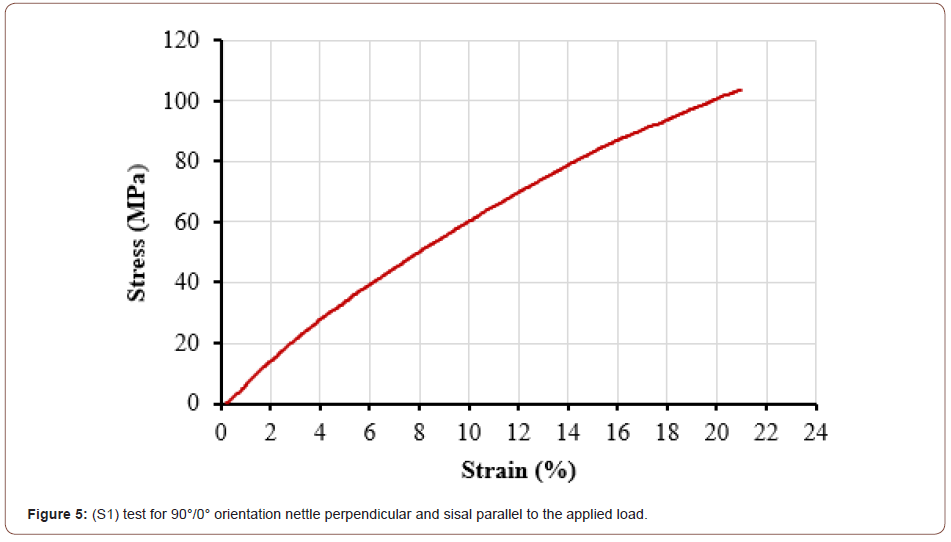
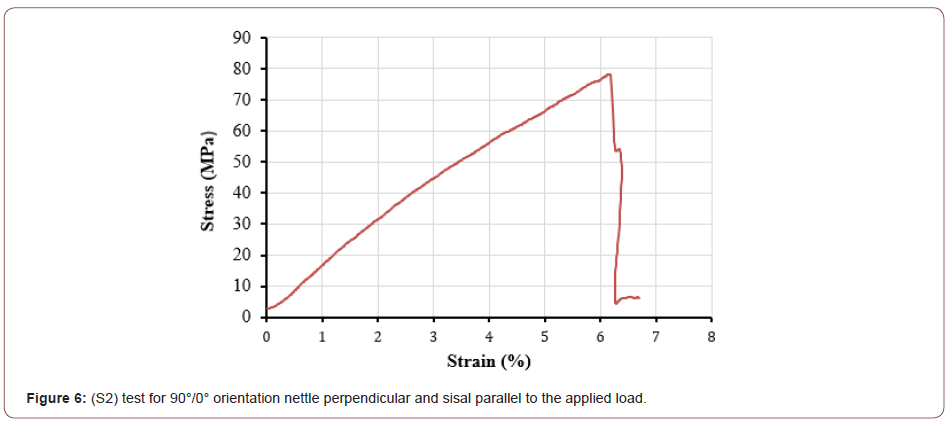

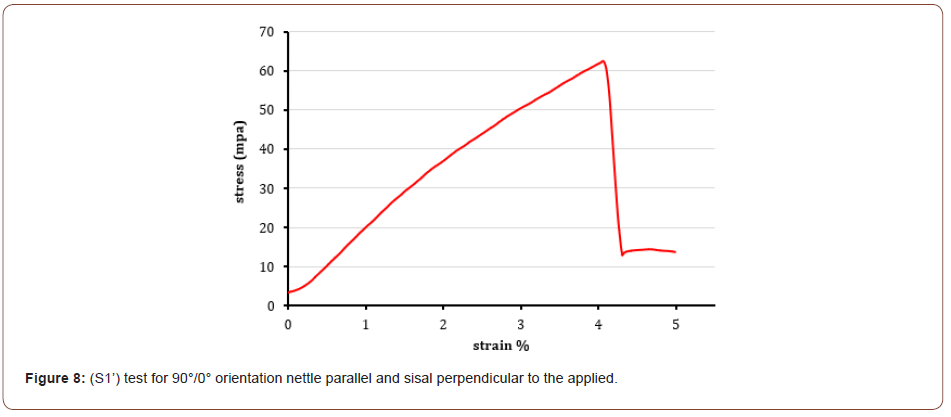
Similarly, the Tensile results of 90°/0° fiber orientation composite in Figures 8, 9, and 10 (sample 1’, 2’ and 5’) shows that the material with nettle, sisal, glass fiber, and polyester resin composite has a tensile strength of 57 MPa, 57 MPa, 91 MPa with a strain of 4.1%, 1.5%, and 18.6% elongation respectively. In this case of fiber orientation, the nettle fibers longitudinal direction arrangement is parallel to that of the applied force vector and the sisal fiber is perpendicular to the applied force, the matrix force transmitting component from one fiber layer to another is expected to fail early due to layer separation.
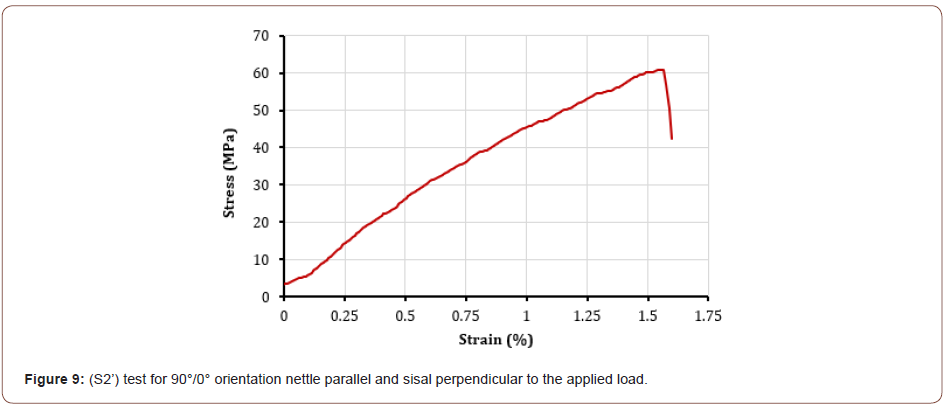
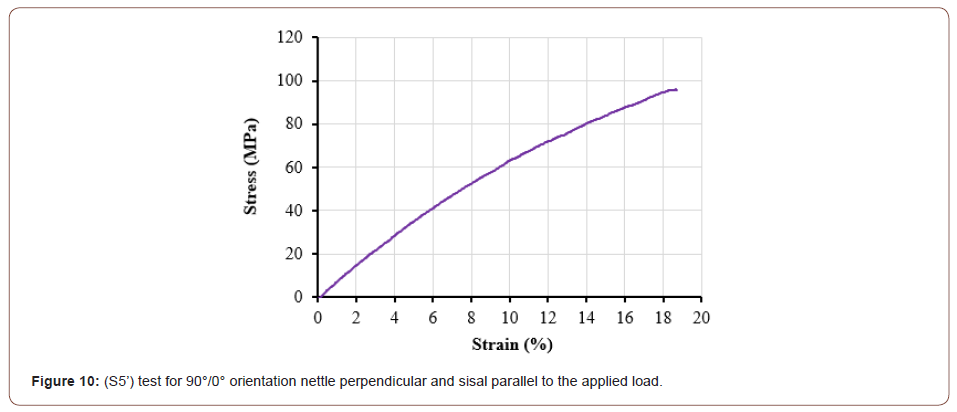
Finally, the graph of 45° fiber orientation was shown in Figures 11, 12 and 13 shows that the material with nettle, sisal, glass fiber, and polyester resin composite has a tensile strength of 52 MPa, 59 MPa, 83 MPa with a strain of 5.0%, 5.4%, and 6.3% elongation respectively. The matrix force transmitting component from one fiber layer to another is expected to fail early due to layer separation.
Impact characteristics
Charpoy Impact Test was used to determine the impact properties of the material. Figure 14 shows the Impact Strength comparison of different compositions. From this Fig, it can be seen that 20NF, 10SF, and 10GF %w composition and 90/0 degree fiber orientation composite (sample 1) impact strength was found to be 8.7 joules. In general, the figure showed that the impact strength of 90/0 degree orientation was found to be better than that of 45-degree orientation for the same composition %w. This difference occurs may be due to the effect of fiber orientation and the amount of nettle fiber composition. The same as tensile strength it can be concluded that increasing nettle fiber %w through 90/0 orientation was withstanding high impact strength. The optimum fiber and matrix interaction, fiber-matrix stress transfer efficiency, and fiber dispersion and distribution were good for sample 1. For the same fiber orientation sample, 2 and sample 5 but different composition %w observed 7.8 J and 6.9 J respectively. The difference was occurred due to fiber composition ratio and due to fiber and matrix interaction.
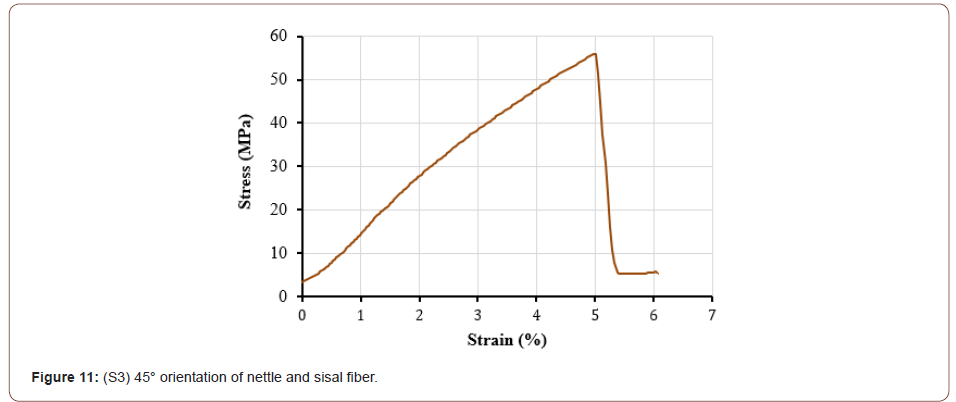

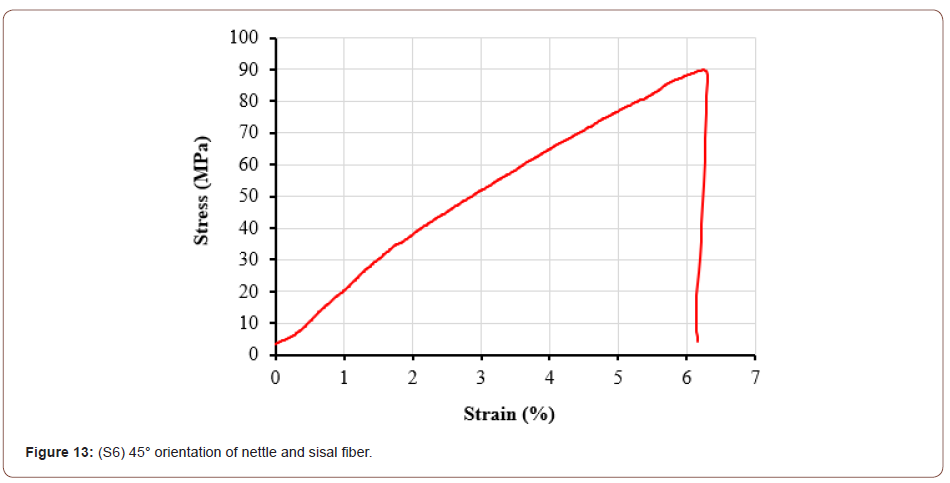
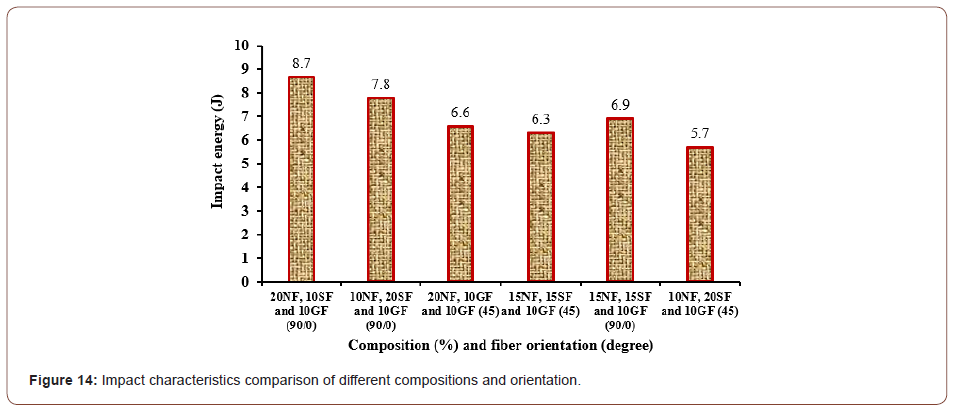
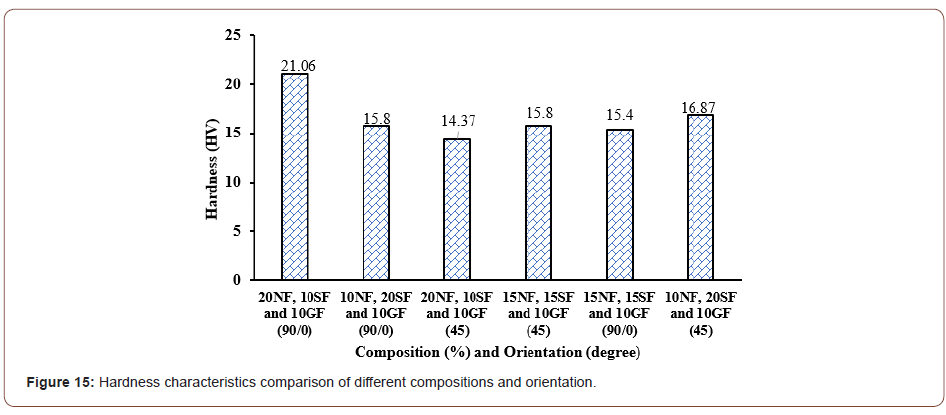

The result obtained in samples 3, 4, and six were lower than the result obtained in samples 1, 2, and 5. The results indicate that the impact strength value of natural fiber hybrid composite was affected by fiber orientation. 90°/0° fiber orientation gives better impact strength than 45° orientation even for the same fiber composition %w. For the same fiber orientation, the variation of the value may also occur due to curing time.
Hardness characteristics
Figure 15 shows the microhardness result of fabricated hybrid composite. The hardness of a material is the resistance offered by the material to deformation, indentation, or scratching when encounters another body. Microhardness tests are conducted to determine the hardness of the hybrid natural fiber polymer reinforced composite materials. Shows maximum hardness value was achieved for sample 1. Because the indentation surface area of the sample covered a small area. Sample 2 and 5 for the same orientation but different composition ratio %w exhibited less hardness value. These were due to the large surface area of indentation. For samples 3, 4, and 6 (450) exhibited less Vickers hardness value. The reason was the same to sample 2 and 5, the recorded high surface area of indentation.
In other ways, the strength property and hardness property of materials have a direct relation. As the amount of nettle fiber increases then the value of tensile strength of the composite as observed from sample 1 increases implies that the hardness of the composite also increases (Figure 15).
From the experiment, it is better to say that as the volume content %w of nettle fiber (90°/0°) orientation increases then mechanical hardness also increases. But if the volume content of nettle fiber (90°/0°) decreases then the corresponding hardness value also decreases. In the case of sample 2 and sample 5, it may be because of the surface finish of the test specimen taken for the hardness test. Additionally, the fiber orientation also affects the hardness of the expected composite as observed from samples 3, 4, and 6 oriented 45°. Finally reducing sisal fiber weight percentages reduces the hardness value of composite materials by reducing load transfer and the interfacial bond between matrix and fiber for samples 1, 2, and 5.
Water absorption test result discussion
Figure 16 shows the water absorption result of the composite. The water absorption behavior of fibers reduces the bonding between the matrix and fibers. This behavior of fiber water absorption can be reduced by chemical treatment. Amounts of water absorption for S1 and S6 were 2.15% and 1.95% respectively. But S1 and S5 absorb a little amount of water. This shows that the bonding between the matrix and the reinforcement or the fibers was good. The effect on strength of the composite show decreasing.
Machinability test
The result under the machinability test shows that the different features of machined fiber pull out and fiber fracture occurred around the drilled hole of some fabricated composite materials. Figure 17 shows a drilled hole on the surface of the composite. Samples were drilled with different size diameters of drill bit but under the same speed and feed rate. The better surface finish was obtained for sample five (S5) which was composed of equal fiber %w composition with 0°/90° orientation. The result shows that the different problem of machining composite like cracking, fiber fracture, fiber pullout from the matrix, plastic flow in the matrix and delamination is improved hybridizing nettle and sisal fiber in equal %w composition and 0/90 fiber orientation. Figure 17 (a) shows that the morphological structure of S5 under SEM. It shows a very smooth surface when compared with S1 Figure 17 (b). This was the result of the interaction between fiber and matrix because of the appropriate proportion ratio and fiber orientation.
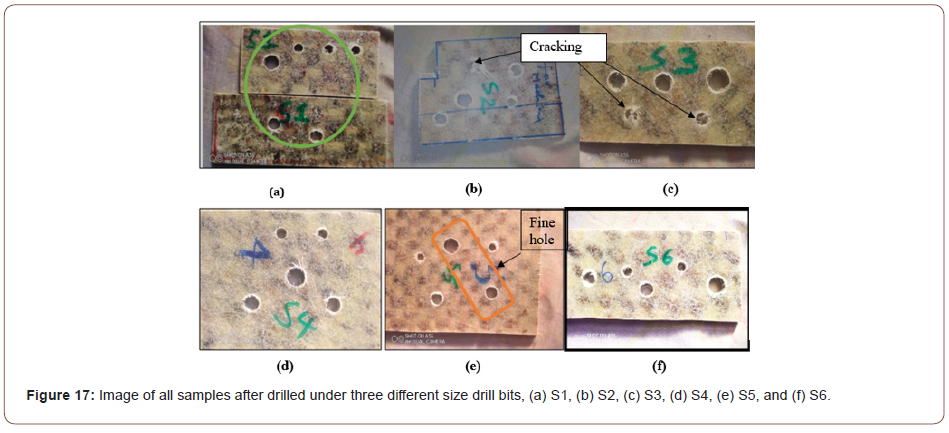
Morphology
Morphology of the composite for sample S1 which has the highest strength and hardness was shown in Figure 18 (a and b). The morphology was characterized using scanning electron microscopy (SEM). The surface finish of sample) is good. It shows that as wt.% of nettle fiber increased then the interaction between fiber and matrix was good rather than decreasing wt.% of nettle fiber. There was an accumulation of matrix on a different surface of the product. This may occur due to the surface interaction of the reinforcement and the matrix. Figure 18 (b) shows the failure mode of the composite after the tensile test. In other ways, the distribution and homogeneity of the reinforcement have better adhesion between fiber and matrix. It can be generalized that the interaction between fiber and matrix was better when the composition of nettle fiber is greater than or equal to the composition of sisal fiber.
Morphological structure

Conclusion
This work shows that successful fabrication of composites with different fiber compositions and orientations is possible by hand lay-up process.
• Different mechanical properties of the product were determined from different fiber orientations. In a tensile test, 20NF, 10SF, and 10GF (S1) composition and (90°/0°) degree orientation of specimen shows the highest or good tensile strength of 99MPa. But the result was obtained if the load applied is through the longitudinal direction of sisal fiber.
• When the direction of the applied load was changed then the tensile strength was reduced. S5 which was composed of fiber %w 15NF, 15SF, and 10GF and oriented (90°/0°) orientation was withstood best tensile strength even if the applied load was applied through both fiber longitudinal direction.
• In the Charpy impact test, S1 shows the highest impact strength of 8.7J. The impact strength of S5 was also good. • Similarly, for the characterization of the hardness test, the S1 specimen shows the highest hardness value of 21.06 HV. But in the case of S5, the hardness value was not that much good. This was maybe due to the surface finish of the sample taken for this test.
• The mechanical property of the composite was affected due to the fiber orientation and composition %w, as observed from the microscopic view.
• It was concluded that a combination of two natural or natural/synthetic fibers enhanced the mechanical properties of the composites with values higher than those obtained for the individual fiber reinforced polymer composites.
To read more about this article...Open access Journal of Modern Concepts in Material Science
Please follow the URL to access more information about this article
To know more about our Journals...Iris Publishers
To know about Open Access Publishers





No comments:
Post a Comment